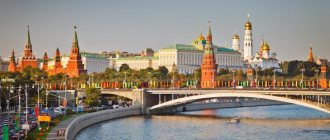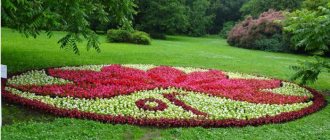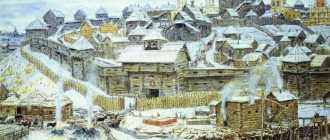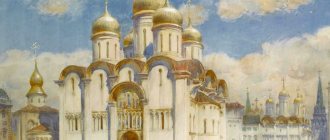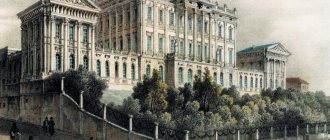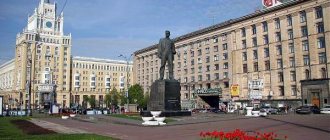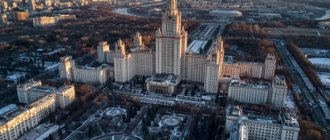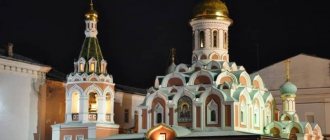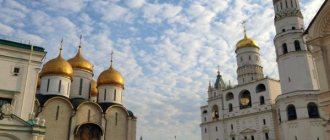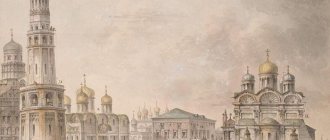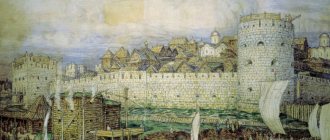The Triumphal Arch or Triumphal Gate is an iconic landmark of Moscow, located on Kutuzovsky Prospekt (in the Poklonnaya Gora area), it immortalized the feat of Russian soldiers who defeated Napoleon's army. Throughout history, not only the appearance of the gates changed (initially they were wooden), but also their location - until 1936 they stood on Tverskaya Zastava Square (the modern square of the Belorussky Station), then they were dismantled, later installing a copy in their current location.
The majestic arch attracts the eye and is considered a real decoration of Kutuzovsky Prospekt. These days the arch is not a travel pass; a pedestrian area with flower beds and benches leads to it, which is convenient for tourists who can, without haste, get acquainted in detail with the architecture of the structure, which has many interesting details, and also take photographs as a souvenir.
Where is the Arc de Triomphe in Moscow, how to get there
The Moscow Triumphal Gate (the second name of the Moscow Triumphal Arch) is located near Poklonnaya Gora and the Battle of Borodino Panorama. Three objects connected by one theme form the Victory complex. The arch is installed on a walking platform separating oncoming traffic on Kutuzovsky Prospekt. Its coordinates: 55°44′12″ N. w. 37°31′11″ E. d.
Buses, trolleybuses and 22-number minibuses stop at the Park Pobedy ground public transport stop. But it is more convenient to get here by the fastest form of transport in the capital - the metro. The Victory Park station is located on the Arbatsko-Pokrovskaya line, dark blue.
Nikolaevsky triumphal gates in Vladivostok
The Nikolaev Triumphal Gate in Vladivostok was built in honor of the arrival of Tsarevich Nicholas.
Photo: Commons.wikimedia.org / Russian.dissident The Nicholas Triumphal Gate in Vladivostok was built to honor the arrival of Tsarevich Nicholas (later crowned Nicholas II) in 1891, during his trip to the Far East.
The construction was carried out with private funds: industrialists, merchants and other wealthy residents of the city took part in it.
The arch did not last long: with the advent of Soviet power, it was demolished. It was decided to restore it in the year of the 135th anniversary of his birth and the 85th anniversary of the death of the last Russian emperor. In May 2003, its grand opening took place.
General characteristics of the arch
The arch on the Kutuzovskaya Mainline is a copy of a structure designed in the 19th century by O.I. Beauvais. The famous Russian architect, who rebuilt Moscow after the fire of 1812, by order of the emperor, created a memorial to the Victory of Russian weapons in the bloody war with the French.
The arched gate is formed by two pylon supports, symmetrically surrounded by six columns each. On the front side of the arch, facing the Mozhaisk Highway, in niches with pedestals there are sculptures of warriors in ancient Russian clothes. These are allegories of Victory and Courage. Goddesses of Glory fly next to them.
Above them, in the upper part of the pylons, there are high reliefs with the compositions “The Expulsion of the French from Moscow” and “Liberated Moscow”. Even higher, under the cornice, there is a belt of 44 coats of arms of the defender cities of Russia. At the very top of the arch there is a rushing six horses, controlled by the goddess of victory - Nike, greeting the defenders of the Fatherland with a laurel wreath. The total height of the structure is 28 m.
Amur Gate in Irkutsk
These gates were built to meet Governor General Nikolai Muravyov-Amursky , who signed an agreement with the Chinese Empire on the Amur and was returning to Irkutsk. Under this treaty, Russia received the left bank of the Amur and vast territories. In addition, it was this document that determined the border between states. In 1891, the gate was reconstructed, but after 29 years it fell into disrepair again and was demolished. During the celebrations of the 350th anniversary of Irkutsk in 2009, it was proposed to restore the gates, but work was never started.
Amur Gate on a 19th century postcard. Photo: Commons.wikimedia.org
History of the creation and existence of the monument
The Arc de Triomphe in Moscow was built in 1814 to welcome Russian troops who were returning from a victorious campaign, having completely defeated Napoleon's troops. Head of the Cabinet of Ministers S.K. Vyazmitinov issued an order to organize the celebrations, sending it to all provinces.
At the same time, Emperor Alexander I, who signed a peace treaty with France, notified Moscow mayor F.V. of the end of the war. Trampling. Preparations have begun for the solemn meeting of the winners and the celebration of the long-awaited peace.
Triumphal Gate at Tverskaya Zastava
The European tradition of erecting such structures in honor of the winners of grandiose battles was born in Ancient Rome. They were placed (permanently or temporarily) for the ceremonial entry of soldiers into the city. The first front gates in Russia appeared under Peter the Great.
Construction of victory monuments began simultaneously in three cities:
- in Moscow near the Tverskaya Zastava (now the Belorussky Station Square);
- in St. Petersburg at the Narvskaya Zastava (near the Obvodny Canal);
The Arc de Triomphe in Moscow and St. Petersburg are almost twin brothers
- in Novocherkassk, the capital of the Don Cossacks.
The Tverskaya outpost of Moscow was not chosen by chance; this is the official place of the emperor's ceremonial welcome upon his return from Western Europe.
The erected wooden arch towered above the Moscow low-rise buildings and made a grandiose impression. They almost managed to complete the construction in Narva when the emperor ordered to curtail all work on the magnificent celebration of the event.
Alexander I was afraid that large gatherings of people would develop into riots. The Novocherkassk arch did not have time to appear then. But in 1817, in anticipation of the emperor’s arrival in the city, two similar structures were erected there, not knowing which side to wait for the autocrat. Now the city is decorated with two attractions dedicated to one event - the Western and Northern City Gates.
Construction of the Arc de Triomphe by Osip Bove
Both wooden arches (in Moscow and St. Petersburg) fell into disrepair after a few years and were dismantled. However, in the northern capital, under the leadership of the architect V. Stasov, they began to build a front gate made of stone in the same place.
Nicholas I, during his coronation (1826), noted that it would be a good idea for Moscow to restore the lost structure. Work on the project was entrusted to O.I. Bove, the document was approved only three years later.
Construction began immediately after the adoption of the project; by the time the authorities organized the celebration of the ceremonial laying of the Arc de Triomphe, part of the foundation had already been done. A memorial plaque and “for good luck” - several silver rubles were placed in the prepared place.
Architect and architecture
Osip Ivanovich Bove is known for leading the construction and reconstruction of buildings in the central regions of Moscow after the fire of 1812. He was born in 1784 in St. Petersburg. His artist parents met in Russia when the Neapolitan Vincenzo Giovanni Bova came to work at the Hermitage. They christened the child the name Giuseppe, but everyone called him Osip Ivanovich in Russian.
Having received his education in Moscow, he found himself in a group of architects who worked under the leadership of the great architects M.F. Kazakova and K.I. Russia. When the Patriotic War began, he went to serve as a cornet in a hussar regiment.
Upon his return, he was appointed to the “Commission on the Structure of Moscow”, where he was responsible for the city center: Arbatsky, Tverskoy, Presnensky and other districts. In 1814 Osip Ivanovich became the chief architect. Thanks to him, the new, post-war Moscow was rebuilt in a single plan, on a grand scale, becoming a monumental city.
Under the leadership of Bove, the territories adjacent to the Kremlin were transformed: the ditch was filled in, the Alexander Garden was laid out, and the Trading Rows were rebuilt (later replaced by GUM). Thanks to him, Teatralnaya Square with the Bolshoi Theater appeared, the Manege, churches, residential buildings, and the Pervograd Hospital were built. The main style of architectural structures is classicism.
Osip Ivanovich died in 1834 in Moscow and was buried in the Donskoy Monastery cemetery.
Construction of the Arc de Triomphe. Materials used in creation
The triumphal arch in Moscow was built in 1829 over a period of 5 years. The material for it was carefully selected. The pylons were made of brickwork. The stone used was from strengthening the banks of the Samotechny Canal, which at that time was subject to dismantling. For wall cladding, material was extracted in the village of Tatarovo, Moscow district (now the territory of Moscow).
That stone was called “Tatar marble”. 12 columns, statues and a quadriga with the goddess Nike were smelted from cast iron. Artists I.T. worked on the sculptural decoration. Timofeev and I.P. Vitali. They performed compositions using Beauvais' drawings.
An important element was a marble plate with the words of dedication approved by Nicholas I. The inscription in Russian and Latin contained gratitude to Emperor Alexander I, who defeated Napoleon and revived the burned city.
On both sides of the main structure, stone buildings were erected to house the guards on duty. The structures were connected to the arch by a lattice decorative fence.
On the eve of the 100th anniversary of the victorious end of the war with Napoleon, in 1912, the monument was repaired and brought into proper shape. The next major work to update it was carried out by N.D. Vinogradov already in the mid-20s of the last century. Triumphal Moscow Arch O.I. Beauvais existed for 102 years.
Don’t miss the most popular article in the section: Belgorod Fortress in Belgorod - why it’s unique, historical facts and excursions.
Alexander Alexandrovich SmirnovARCH OF TRIUMPH IN MOSCOW
In mid-1814, for the solemn welcome of the victorious Russian troops returning from Western Europe, a wooden Triumphal Arch was built at the Tverskaya Zastava (at the end of what is now Gorky Street). But the monument quickly deteriorated, and 12 years later, in 1826, it was decided to replace the wooden Arc de Triomphe with a stone one. The drawing up of the project was entrusted to the largest Russian architect Osip Ivanovich Bova. In the same year, he developed its initial project. However, the decision to redesign the front square at the main entrance to Moscow from St. Petersburg led to the need to rework the project. The new version, which Bove worked on for almost two years, was adopted in April 1829.
The ceremonial laying of the arch took place on August 17 of the same year. A bronze plaque was embedded in the base of the future monument with the inscription: “These Triumphal Gates were laid as a sign of remembrance of the triumph of Russian soldiers in 1814 and the restoration of the construction of magnificent monuments and buildings of the capital city of Moscow, destroyed in 1812 by the invasion of the Gauls and with them the twelve languages.” .
The construction of the Triumphal Gate, the first and only arched monument in Moscow built after the War of 1812, took five years due to a lack of funds and indifference on the part of the city authorities. Only on September 20, 1834, the opening of this unique monument took place, reflecting the military power, glory and greatness of Russia, the heroism of its victorious soldiers. Bove created a bright, expressive image of unconquered Moscow, rising “from the ashes and ruins,” as one of the inscriptions on the arch said.
The ensemble of the Triumphal Gates stood at the Tverskaya Zastava for 102 years. In 1936, the square near the Belorussky railway station, where the arch stood, was decided to be redesigned and expanded to relieve congestion on the Gorky Street - Leningradskoye Shosse transport highway. The triumphal arch, guardhouses (rooms for military guards) and the remains of the forged fence that once connected them were dismantled. The rich sculptural decoration of the arch was kept for 32 years in a branch of the A. V. Shchusev Museum of Architecture (on the territory of the former Donskoy Monastery). There, you can still see to the right of the northern entrance to the Great Cathedral fragments of old casting - cast iron boards with relief military armor and coat of arms, the base and capital of one of the columns.
In 1966, the Moscow Council of Workers' Deputies decided to restore the Arc de Triomphe in a new location. The team of the 7th workshop of Mosproekt-3 worked on the project. The task before him was not an easy one: after all, in the cornice crowning the arch alone, it was necessary to place 1276 independent parts. Architects, artists and engineers had to use the surviving measurements, drawings and photographs to recreate the original appearance of the monument, replacing the lost decorative elements. Led by one of the elders of Moscow restoration, V. Libson, the leading team of restorers, consisting of architects D. Kulchinsky and I. Ruben, engineers M. Grankina and A. Rubtsova, boldly got down to business.
Sculptors-restorers of the Production and Art Plant of the USSR Ministry of Culture on Profsoyuznaya Street, having carefully studied archival materials, prepared plaster casts and molds of parts that were to be cast anew. More than 150 models were prepared - exact copies of each restored decorative element.
Experienced masters of artistic casting using plaster molds again cast individual figures, lost parts of military armor and coats of arms of old Russian cities, as well as reliefs with military attributes instead of the original ones, mounted in the walls of the lobby of the Battle of Borodino panorama museum in 1962.
The minters also worked a lot on the castings. Great skill was required to assemble reliefs with images of ancient warriors, pyramids of military armor from scattered parts, and to recreate the lost fragments of the cast iron “clothing” of the Triumphal Gate.
The question of a new location and the scope of restoration work has caused a lot of controversy and proposals. Some believed that the Arc de Triomphe should be restored on the Leningradskoye Shosse, not far from the Belorussky Station Square. Others believed that the arch should be taken outside the city limits, to Poklonnaya Hill, and restored certainly as Bove created it, that is, with small, richly decorated guardhouses symmetrically located on both sides of the arch. Like mighty wings, the guardhouses were connected to the body of the arch with an openwork forged lattice. This ensemble at one time created a very successful architectural completion of one of the main Moscow highways. However, the architects of the 4th workshop of Mosproekt-1, which decided on placement issues, were convinced that the Triumphal Gate should be restored as a monument, that is, without guardhouses, at the entrance square of Kutuzovsky Prospekt.
The problem of installing a grandiose monument was not limited to choosing a location on Kutuzovsky Prospekt. If Bove placed the arch on the outskirts of the capital, among small houses, where it was the center of the architectural composition, then modern city planners had to install the monument in the existing urban landscape, among tall buildings that were larger than the arch. It was necessary to erect the monument so that it would not be covered by multi-story buildings, so that it would not get lost between them, and so that its unique decorative decoration could be seen from a distance. The architects recognized the current Victory Square as the most suitable location. Now the Arc de Triomphe was erected without guardhouses and fences, not as a traffic gate, but as a monument in such a way that busy traffic flows around it on both sides, and it unites and decorates the space between the surrounding houses, without at the same time merging with them.
After the Executive Committee of the Moscow City Council approved the project for the reconstruction of the entrance square to Kutuzovsky Prospekt, the builders began work. They had to make the area around the future arch absolutely flat, tear down the hill near Staromozhaiskoye Highway, build a new 15-meter-wide passage for vehicles and an underground passage connecting both sides of the avenue with the area in the middle of the roadway where the arch would grow.
Concrete workers, facing workers, installers, stone cutters and welders of the 37th Construction Department of the Trust for the Construction of Embankments and Bridges worked with great love on the construction of the monument.
On November 6, 1968, Beauvais’s wonderful creation found a second life. Through the work of designers, restorers and builders, perhaps the most grandiose Moscow monument in honor of the victory of the Russian people in the Patriotic War of 1812 was recreated.
The triumphal arch now stands on Victory Square, not far from Poklonnaya Gora, forming a single historical and memorial complex together with the panorama museum “Battle of Borodino”, “Kutuzovskaya Izba” and the monuments located next to them.
The front side of the arch faces the entrance to the capital. By placing it in this way, the architects followed the old tradition, according to which triumphal gates and arches were always placed with the main facade facing the road leading into the city.
The basis of the monument is a single-span arch with six pairs of free-standing 12-meter cast-iron columns of the magnificent Corinthian order, located around two arched supports - pylons. The columns, weighing 16 tons each, were re-cast in Moscow from the details of the only surviving old column. Between each pair of columns, in the niches formed by them, on high pedestals there are powerful cast figures of warriors with heart-shaped shields and long spears, in ancient Russian chain mail and pointed helmets, with cloaks thrown over their shoulders in the form of Roman robes. The bearded faces of the knights are stern and expressive. The rhythmic, somewhat artificial poses of the warriors, their tight, Roman-style tunics are a tribute to the classical image that dominated at the beginning of the 19th century.
Above the figures of warriors, in the upper part of the pylons, there are skillfully executed, graceful, full of dynamism high reliefs. The relief “The Expulsion of the French,” called by its creators “The Expulsion of the Gauls from Moscow” or “The Slaying of the Twelve Tongues,” depicts hand-to-hand combat against the backdrop of the battlemented Kremlin wall. Russian soldiers in ancient armor, irresistibly approaching from the right in dense ranks, are pushing back the enemy, whose army is running, throwing away their weapons. In the foreground is a Russian warrior. In his left hand he holds a round shield with the coat of arms of Russia. With a swing of his right hand, he raised his sword over his defeated enemy. The figure of a Russian warrior, as if brought to life on the relief, embodies the power of the peoples of Russia who rose up to fight the conqueror. The horror and doom of the enemies is contrasted with the firm confidence and boundless determination of the Russian soldiers - the liberators of Moscow. The figure of a killed enemy warrior with his bare chest is also expressively executed.
The composition is masterfully solved. The impression of movement is enhanced by the creation of spatial depth. The figures in the foreground and in the depths of the relief are different in size, and the nearest figures are almost independent sculptures. However, this does not prevent the high relief from successfully fitting into the plane of the wall of the Arc de Triomphe. Convention and reality are merged here. The relief is executed with great patriotic feeling, passion and deep vitality of the drawing.
Another high relief, “Liberated Moscow,” was made in a calmer manner. The reclining Russian beauty, resting her left hand on a shield with the ancient Moscow coat of arms, which depicts St. George the Victorious slaying a dragon, personifies Moscow. Her figure is dressed in a sundress and a robe, and her head is adorned with a small crown. She extends her right hand to Emperor Alexander I. He is wearing the rich dress of a Roman Caesar. These central figures are surrounded by images of Hercules with a club on his right shoulder, Minerva, an old man, a woman and a youth. The backdrop for them is the battlemented wall of the Moscow Kremlin.
In the clothes of the characters, a combination of Russian national features with ancient ones is noticeable, as in the previous relief. Undoubtedly, this high relief is in many ways inferior to “The Expulsion of the French,” but they are close to each other in a direction that goes beyond the traditional framework of classicism and acquires the features of romanticism.
Traditional figures trumpeting the victory of Slavs hover in the walls above the bends of the arch. And along the entire perimeter of the strongly protruding cornice are placed the coats of arms of the administrative regions of Russia, the population of which participated in the fight against the aggressor.
Above the cornice, allegorical statues of Victories froze in calm poses, clearly standing out in the bright foyer of the attic. The seated figures are strictly oriented along the verticals of the pylons and seem to crown each pair of columns. War trophies are piled at the feet of Victory. In the hands of the goddesses are wreaths and scepters as symbols of ruling victory. Classically stern faces are enlivened by a slight smile.
The arch is crowned by the chariot of Glory, as if flying over the attic. Six horses, moving at a measured pace, pull the chariot. The winged goddess of Victory stands proudly in the chariot. With a laurel wreath raised high in her right hand, she crowns the winners. The dense, rounded shape of her body breathes energy. The gaze of the ancient Greek goddess is turned to those entering the capital. She seems to be trying to tell them the good news about the victory of Russian weapons.
It is interesting to note that the Moscow Metropolitan refused to consecrate the Arc de Triomphe at its opening in 1834 because of the placement of sculptural images of mythological gods on it.
In the center of the attic, above the roadway, on both sides of the arch there are memorial plaques with inscriptions. The one that looks at the city is made up of the words of M.I. Kutuzov, addressed to Russian soldiers in 1812: “This glorious year has passed. But your great deeds and exploits done in it will not pass away and will not be silenced; posterity will keep them in their memory. You saved the Fatherland with your blood. Brave and victorious troops! Each of you is the savior of the Fatherland. Russia greets you with this name.” The text of the mortgage board is repeated on the main façade. And, reading these lines, we, the descendants of the fifth generation of heroes of the twelfth year, seem to lose the sense of time and seem to stand next to those who fought at the walls of Moscow, who raised it from the ruins, who accomplished their military and labor feats more than 160 years ago .
The walls of the arch are lined with white stone, mined near the village of Tatarova near Moscow. At one time, Bove partially used the white stone that was used to decorate the Mytishchi gravity water supply system; it was then being rebuilt. The skillful combination in one monumental structure of various materials and contrasting colors - black cast iron and white stone - enhances the artistic expressiveness of the monument.
The architectural and sculptural concepts in it are in complete unity. The masterfully conceived and executed staging of the arch sculpture perfectly took into account the play of light and shadow of its parts. You can easily verify this if you walk around the arch at sunrise or sunset, i.e., at its maximum illumination. Due to the fact that the columns and the warrior figures standing between them are not adjacent to the wall of the arch, the light seems to flow around them and, reflecting from the white walls, additionally illuminates the black figures from behind and from the sides.
The creators also found an excellent solution for the harmonious architectural proportions of all elements of the Arc de Triomphe. Try to mentally increase the height of the warrior figures - and they will interfere with the perception of the high reliefs. Change the dimensions of the arch base and you will have to change the dimensions of the cast iron columns. Raise the arch above its current 28 meters - and all its stucco decoration will become small and will be lost against the background of the wall openings. This confirms the correctness of the chosen proportions and their strict interdependence.
Talented Russian sculptors Ivan Petrovich Vitali and Ivan Timofeevich Timofeev helped express the idea of a clear and calm consciousness of Beauvais’ victory. They carried out most of the work based on the drawings of the architect, who outlined the sculptural decoration of the arch. In the works of Vitali and Timofeev one can feel the desire for simplicity and truthfulness. Their works are distinguished by restraint and majestic calm.
The perfect beauty of the form, the vitality of the sculpting, the firmness of the lines speak of the sculptors’ deep understanding of the essence of ancient art and the appearance of realistic motifs in their works. The merit of Vitali and Timofeev is that in the composition of the Arc de Triomphe, monumental sculpture is successfully combined with massive architectural forms.
The names of the creators, the history of the construction and renewal of the Arc de Triomphe are written on a commemorative cast-iron plaque installed under the arch of the arch: “The Moscow Triumphal Gate in honor of the victory of the Russian people in the Patriotic War of 1812 was built in 1829-1834. designed by the architect Osip Ivanovich Bove, sculptors Ivan Petrovich Vitali, Ivan Timofeevich Timofeev. Restored in 1968."
Nine years have passed since the arch was recreated, and in September 1977 it was again surrounded by scaffolding. For several weeks, roofers, sandblasters, sealers, welders, mechanics, installers, lapidaries, and masons of the Mosstroy No. 7 trust worked here, replacing each other. The roofing felt roof of the arch under the hooves of bronze horses was replaced with theocol mastic, which is more resistant to rain, snow and sun. , lined with fiberglass; zinc coating - copper with a reinforced fastening system. In some places, the corrosion deposit that appeared on the casting was cleaned off to a shine, and these places were covered with red lead and special black paint with a dark green antique tint. The granite plinth was renewed, the walls and inscriptions were cleared, and the slabs on the area surrounding the arch were leveled.
The Triumphal Arch is a beautiful symbol of victorious Moscow, imbued with the idea of the triumph of the Russian people, it is the main monument to the Patriotic War of 1812 in the capital, it is a visible embodiment of the deep gratitude of descendants to the victorious heroes. “Russia must solemnly remember the great events of the Twelfth Year!” - wrote V. G. Belinsky. And the recreated Arc de Triomphe on Victory Square is the best confirmation of this.
© 1981, ed. “Moscow worker”, “Moscow to the heroes of 1812”, Smirnov Alexander Alexandrovich. Published with the kind permission of the author. The material for publication in electronic form was prepared by O. Polyakov.
Arch dismantling
In 1935, the Soviet government approved a large-scale General Plan for the Development of Moscow. It provided for measures to demolish some buildings, expand and update avenues and streets, and erect new structures needed by the city.
It was in light of the implementation of this plan that an action previously unprecedented for the capital was carried out: some Moscow houses were moved to the side, making way for transport routes.
A group of architects led by A.V. worked on the project for the reconstruction of the Tverskaya Zastava, which by that time had become a major transport hub. Shchuseva. They decided to dismantle the Arc de Triomphe while the excavation work was being carried out, and restore it upon completion.
To this end, the dismantling of the structure was approached with all responsibility. Each photographed element was subject to sketching, inventory, measurement and storage. But a war began, which disrupted many plans. All cast iron columns (except one) were sent for melting down - the warring country needed metal.
In December 1965, at a meeting of the Moscow City Council, a decision was made to restore the Arc de Triomphe as a significant historical and artistic object.
The troubled fate of the monument
In 1872, a horse-drawn line from Tverskaya Zastava to Voskresenskaya Square (now Revolution Square) passed under the gate. In 1899, it was replaced by the city's first electric tram, launched from Strastnaya Square (now Pushkinskaya) to Petrovsky Park. Intense traffic could not but affect the condition of the monument, and on the centennial anniversary of the Battle of Borodino, the gate underwent its first restoration - cosmetic for now. The next renovation took place under Soviet rule, in the mid-1920s [2, 3].
In 1936, Tverskaya Zastava began to be rebuilt in accordance with the General Plan for the Reconstruction of Moscow, adopted a year earlier. The triumphal gate was dismantled, with plans to later return it to its original location after careful restoration. During dismantling, specialists from the Museum of Architecture named after A.V. Shchusev measured the parameters of the structure, drew up detailed drawings of the tiers and photographed the arch from all sides. Most of the elements were cleaned and updated, and then sent for storage to a branch of the museum on the territory of the Donskoy Monastery. They fit quite organically into the overall composition: the figures of warriors lined up along the central alley, the high reliefs were placed in wall niches, and the chariot of Glory was installed on a special pedestal.
The restoration of the gates was not postponed indefinitely - it was pushed back by the Great Patriotic War, after which the capital, like the entire country, was essentially rebuilt. The elements in the Donskoy Monastery were patiently waiting in the wings. Much less fortunate, for example, were the cast iron columns: they lay on Miusskaya Square for several years, and then they were melted down for military needs - only one of the twelve survived. It seemed that the monument was destined for oblivion as one of many “relics of the past”...
Relocation of the Arc de Triomphe
A group of specialists led by restorer V.Ya. Libson recreated a copy of the Arc de Triomphe in accordance with the preserved documents. Work was carried out until 1968.
The new building was erected using modern materials and capabilities of that time:
- the pylons, which were previously brick, were made of reinforced concrete;
- the cladding from “Tatar marble” was replaced with Crimean, light gray limestone;
- no fence or guard buildings were erected;
- 150 sculptures were cast again at the Mytishchi plant, and cast iron columns based on the model of the only one that survived were cast at Stankolit;
- one slab with a text of gratitude to Alexander I was left (on the outside of the arch), on the other side there was an excerpt from the order of Commander-in-Chief M.I. Kutuzov in 1812, where he calls Russian soldiers “Saviors of the Fatherland.” The words of the great commander about the courage of the people defending their land made the building a monument to Victory in the wars of 1812 and 1945.
The Triumphal Arch in Moscow was reopened in November 1968, but no longer on the street. Belarusian.
The problem of installing a grandiose monument
The triumphal gates were installed on Kutuzovsky Prospekt, one of the busiest highways in the capital, bearing the name of the great commander-in-chief. In the 60s of the last century, the location of the monument’s construction caused great controversy among experts. Over the past century and a half, the Mother See has changed beyond recognition.
First of all, the city has grown significantly upward. The post-war construction of high-rise buildings suppressed and made the triumphal structure less grandiose. In addition, the city has expanded its borders - what was previously the outskirts is now almost the center.
In 1962, not far from Poklonnaya Gora, a new building of the Borodino Battle panorama museum was opened. The canvas by F. Roubaud, painted in 1911, was removed from storage, restored and placed in a 23-meter cylinder of the building. Poklonnaya Gora is a historical place where in 1812 Napoleon waited for a Russian deputation with the keys to the conquered capital, the Kremlin. I waited in vain.
Having decided to install a third object in a historical place, reminiscent of the Victory of Russian weapons over Napoleon, the architects first prepared the site. To visually maintain the height of the structure, earthworks were carried out to lower the surrounding hills.
It was decided to move the arch away from the multi-story buildings standing on both sides of the avenue. The highway, widened in this place, was divided by an island platform, on which the gate was installed. The Arc de Triomphe is not accessible, the flow of cars goes around it on both sides, and the area to which underground passages lead is completely at the mercy of tourists and vacationers.
Restoration
The Arc de Triomphe underwent a major restoration in 2012, ahead of the celebrations in Moscow of the 200th anniversary of the victory over Napoleon.
During the work, the State Institution “Mosrestavratsiya” carried out the following actions:
- part of the cladding was replaced;
- the remaining facing stone was cleaned;
- the appearance of metal sculptural elements was restored;
- the equestrian sculpture with the goddess Nike was restored, dismantled and then returned to its place;
- reinforced concrete pedestals under the sculptures of warriors were replaced with granite ones;
- the black cast-iron columns became graphite-colored, as the author of the project wanted.
The cost of the work cost the city 230 million rubles.
The Moscow government plans to open an observation deck on the Arc de Triomphe.
Sculptural groups
From the Champs Elysees:
- On the left is the 1810 Triumph on the occasion of the signing of the Peace of Vienna with the figure of Napoleon in the center, the work of the sculptor Jean-Pierre Cortot
- On the right is the Marseillaise or the Revolt of Volunteers against the Prussian troops who occupied Lorraine in 1792, the work of the sculptor Ryud
From the side of Avenue de la Grande-Arme - works of the sculptor Antoine Etex:
- Left - The World of 1815, allegorical composition
- Right - Resistance of 1814
What does the Arc de Triomphe look like in Moscow today?
A majestic, beautiful building greets those arriving in the city from the western side. After the restoration, the Moscow Gate became even more attractive to tourists.
A safe and landscaped area with flower beds in the middle of streams of rushing cars allows you to examine every detail of the structure and take interesting pictures in the immediate vicinity. At night, the lighting turns on, which makes the monument even more interesting.
Arch sculptures
Osip Ivanovich Bove, working on the project, saw the entire structure as a whole, including decorative elements. He made many drawings, sketches, sketches of figures and other elements that were used by sculptors Ivan Vitali and Ivan Timofeev.
The cast iron sculptures were cast at the Myshechsky plant (Aleksin, Tula province). The black color of the decor contrasted favorably with the white cladding of the arch. After dismantling in 1936, all preserved parts were transferred to the Museum of Architecture.
On the recreated Arc de Triomphe, some of the sculptures are copies; they were made from plaster casts. Authentic compositions and reliefs - a chariot with Victory, figures of warriors, images of Firmness and Courage, as well as flying Glories returned to the monument after restoration.
Unused decorative elements of the Beauvais Arch are on display in the Sculptural Courtyard of the Museum of Architecture at the address: st. Vozdvizhenka, 5/25.
Composition “Exile of the French”
The high relief depicts brutal hand-to-hand combat against the backdrop of the Kremlin wall. Under the onslaught of Russian soldiers, the French flee, throwing away their weapons and looking around in horror. In the foreground is a mighty warrior with a sword in his hand, on his shield is the coat of arms of Russia, at his feet is a defeated enemy with a naked torso.
The figures in the foreground of the composition and in its depth differ in size, which ensures the volume of the scene. Large parts of the high relief are made carefully, almost like jewelry, creating a feeling of living bodies and tension in the situation.
Composition “Liberated Moscow”
A beautiful Moscow woman, dressed in a sundress, with a crown on her head, reclines in a free pose. The background is the Kremlin battlements. She leans on a shield with the image of St. George slaying a serpent with a spear.
Moscow is surrounded by mythological gods and ordinary people: elders, youths, women. Her hand is extended with gratitude to Alexander I, who liberated the city and people from the invader Napoleon.
Bas-reliefs
From the Champs Elysees:
- Left - Presentation to Bonaparte of the captive Turkish military leader Said Mustafa - Pasha after the Battle of Aboukir on July 25, 1799, the work of the sculptor Serre the Elder
- Right - Funeral of General Marceau on September 20, 1796, by sculptor PH Lamaire
From Avenue de la Grande Armée:
- Left - Battle of Arcola on November 15, 1796, the work of the sculptor Feucher
- Right - Battle of Kanob in Egypt July 3, 1798, by sculptor John-Étienne Chaponnière
On the sides:
- The Battle of Austerlitz, depicting the victory over the Russian army on December 2, 1805, located on the side of Wagram Street, sculptor Jean François Geschter
- Battle of Jemappe November 6, 1792, sculptor Carlo Marochetti.
Interesting Facts
In 1899, tram tracks were laid through the Arc de Triomphe, and electric cars, following the route Strastnaya (Pushkinskaya) Square - Petrovsky Park, stopped at a stop with a triple name: “Tverskaya Zastava. Triumphal Gate. Alexandrovsky Station.
In the 19th century, during the opening of the stone arch, Beauvais, the Metropolitan of Moscow, invited to the celebration, refused to consecrate the structure due to the presence of mythological gods in the decor. Local residents called the goddess Nike, holding a laurel wreath, “a woman with a roll.” The Russian peasant, unfamiliar with Greek mythology, understood more clearly the sincerity and hospitality of the Russian beauty with bread and salt.
Some sources claim that the initiator of the post-war restoration of the Arc de Triomphe was the first cosmonaut Yuri Alekseevich Gagarin.
Speaking in 1965 at the VIII Congress of the Komsomol, he noted with regret that we do not take care of monuments that “carry a patriotic beginning.” In response, General Secretary N.S. Khrushchev promised Komsomol members that he would take steps to restore the arch. He kept his word.
During restoration work in 2012, a note-message was found in the ball's construction, which stated that Fyodor Davydov was the last worker to leave the facility in 1968. By analogy, a new capsule was laid, addressed to the descendants of 2062, with a list of everyone who took part in the restoration (232 names).
Analogues of the Arc de Triomphe in the world
The Arc de Triomphe in Moscow has many analogues in the world. Single- and multi-span structures are erected in honor of winners or memorable events. They are usually installed on entrance highways, major roads, at the ends of streets, and on bridges. Several ancient Roman arches from the 200-300s have been preserved, and there are many buildings of modern times.
| A country | City | Year | Event (destination) |
| France | Paris | 1836 | In honor of the Battle of Austerlitz |
| India | New Delhi | 1931 | In memory of the soldiers who participated in the battles of the First World War |
| Spain | Barcelona | 1988 | For the World Exhibition |
| Germany | Berlin | 1791 | The original name of the Brandenburg Gate is the Gate of Peace |
| England | London | 1828 | Entrance to Buckingham Palace |
| Italy | Ramini | 27 BC. | Arch of Augustus - gateway to the city |
| Romania | Bucharest | 1922 | In honor of the defenders of independence |
The triumphal arch of the capital has long been perceived as a monument to the courage and victory of the Russian people in all wars and battles that took place on our land. In Moscow they carefully treat the memory of great events, trying to preserve and pass it on to descendants.
Article design: Mila Friedan
Brandenburg Gate in Kaliningrad
The first wooden gates in Kaliningrad (then Königsberg) were built on this site in 1657, and 100 years later, at the direction of Frederick II, they were replaced with stone ones. Initially, these gates were not triumphal, but served a practical function: they protected the city from enemy raids. There was always a garrison of guards on duty outside the walls, and there were also utility rooms. In the middle of the century, the gates ceased to have a fortification function. In 1843 they were rebuilt and decorated with decorative pediments, cruciform flowers, leaves on the finials, coats of arms and medallions. They also featured portraits of famous Prussian military personnel. The gate was preserved by the Soviet authorities and has survived to this day. Today they continue to perform a transport function, remaining travel cards.
The Brandenburg Gate in Kaliningrad was part of the city’s defense system and served as shelter at the entrance to it. This is the only city gate in Kaliningrad that is still used for its intended purpose. Photo: RIA Novosti / Vladimir Fedorenko
